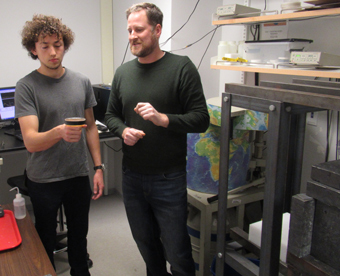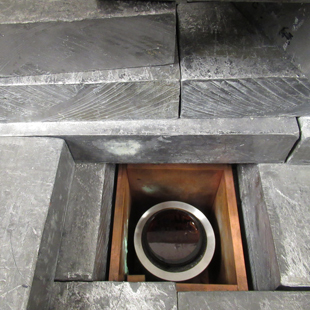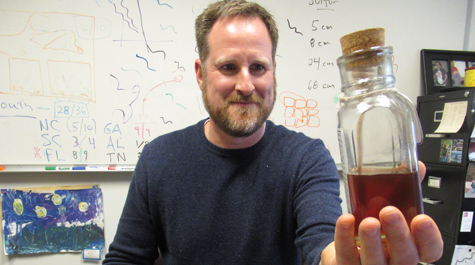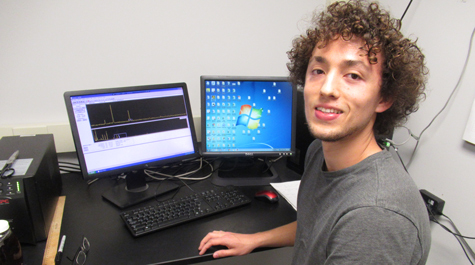A radioactive isotope is showing up in honey
That natural, bee-produced sweetener you stir into your tea and lavish on your toast may be laced with cesium-137.
It’s a radioactive isotope, Jim Kaste explains, a relic of the atom bomb tests of the Cold War. And there is a good chance that your delectable honey contains detectable amounts of the stuff.
Kaste hastens to point out that the levels of cesium he’s found in honey samples — even the highest — are below action levels for human consumption.
“I eat more honey now than I did when I started this project,” he said, gazing at the shelves of jars in his office. “I feed my kids honey. I’m not trying to tell people they shouldn’t eat honey.”
Even if there is no concern about human consumption of honey, Kaste says his work might have bearing on the recent collapse in the population of bees and other pollinating insects.
Kaste is an associate professor in the Department of Geology at William & Mary, where he also serves as director of the Environmental Science & Policy Program. He will be sharing his findings in a presentation to a meeting of the Geological Society of America, along with collaborators Andrew J. Elmore of the University of Maryland Center for Environmental Science and Paul Volante, a William & Mary undergraduate student.
They will present their honey findings on March 20 at the GSA’s Joint Southeastern/Northeastern Section Meeting in Reston, Virginia. As part of the presentation, Kaste will invite other earth scientists to examine honey samples for cesium-137.

Kaste’s research specialty is studying contaminants in the environment, and he uses a variety of techniques to extract hidden facets of the Anthropocene from the earth.
The story begins with the Bomb
How a radioactive isotope found its way into our honey is a story that involves not only geology, but also geopolitics, physics, meteorology, history, chemistry, botany, entomology and the wares of farmers markets. The story begins with the human desire to master the craft of blowing up large parts of the world.
“We invented atomic bombs only in the Forties and Fifties,” Kaste said. “And we started testing them out West in New Mexico and Nevada.”
The fallout from the test bombs produced some of the grimmest unintended consequences imaginable. Ranchers woke up to a range of dead cattle. Cancer clusters began showing up decades later, especially, Kaste said, among the “downwinders” who caught the brunt of the radioactive drift.
“There was a period in which we tested hundreds of nuclear weapons in the atmosphere,” he said. The nuclear tests were moved from the American West to Pacific islands and eventually ended in late 1963 as treaties with the Soviet Union went into effect.
“What that did was put a blanket of these isotopes into the environment during a very narrow time window,” Kaste explained. “That is awesome for geologists because we can use that peak as a tracing tool for sediments.”
{{youtube:medium:center|J01_iUQmQEc}}
He is one of a group of geologists who study the progression of industry through the contaminants deposited in the fine sediment of Lake Matoaka on the William & Mary campus. They know just where to find the atom-bomb age: “Core down, and right about 27 centimeters deep you see this peak in radioactivity from those isotopes,” Kaste said. “And we know that is 1963.”
Cesium-137 results from a nuclear reaction of uranium and plutonium — the fuel of nuclear reactors and bombs. Cesium-137 stays around for a while, as Kaste notes the isotope has a half life of around 30 years. The cesium decays into a short-lived radioactive isotope of barium, which further decays into a stable form of barium.
“Bombs don’t have cesium; bombs have uranium,” he said. “When there’s fission, cesium is basically a fragment of the uranium that flies off.”
Making sense of the maps
Kaste displays a set of maps. They look much like weather maps, except the variously colored areas explain the progression of cesium from explosion to honey jar. The force of the explosions propelled fallout rich in cesium-137 upward and outward, eventually settling to earth. It’s not distributed evenly or randomly.
His first map shows cesium concentration in the U.S., based on studies by the Department of Energy. It doesn’t make any sense. Many of the “hottest” areas, those with the highest nuclear fallout, are most concentrated in the eastern U.S., not in the west, closer to where the bomb tests occurred.
“It’s counterintuitive, right?” Kaste asks. Then he explains: It all has to do with rainfall.
“When these bombs are detonated, some of the debris goes into the stratosphere,” Kaste explained. “And the most efficient way to remove it is by rainfall.”
So the debris-laden clouds drifted over the arid western and Great Plains states, precipitating to earth in the moisture-rich areas east of the Mississippi. Then Kaste shows another map of cesium concentration, this one bearing plots noting sources of his honey samples.
Once again, the map doesn’t appear to make sense: The map has circles denoting locations of “hot” honey. An X marks the spots where the honey was cesium-free. There is no apparent correlation between the hot honey spots and the levels of cesium in the environment.
 Then Kaste gets out a third map. The honey-sample plots are there, but this map shows the range of potassium in the soil. There is a definite, and inverse, correlation: honey samples from low-potassium areas are more likely to be richer in cesium content.
Then Kaste gets out a third map. The honey-sample plots are there, but this map shows the range of potassium in the soil. There is a definite, and inverse, correlation: honey samples from low-potassium areas are more likely to be richer in cesium content.
“Potassium is a really important nutrient for plants,” he said. “And the potassium and cesium atoms look very similar.”
Kaste brings out a copy of the Periodic Table of the Elements. He points to K, atomic number 19, then to Cs, atomic number 55.
“Here they are, in the same column,” he said. “The atoms look very similar in the charge and the size of the ion. So, the reason the cesium gets taken up is that it appears like potassium to the plant.”
Kaste also said the plants can discriminate between the two elements and they prefer potassium — when it’s available.
“People in the Sixties and Seventies showed that if you fertilize your crops, you reduce the chance that you wind up with a contaminant. So, if you’re a plant in potassium-rich soil, you’re going to get potassium,” he explained. “If you’re a plant looking for potassium in potassium-limited soil, you will snag something that looks like potassium. But a plant always prefers the good stuff.”
Flowering plants express the cesium out in the nectar they produce; the bees collect the cesium-spiked nectar and the bomb-to-bee cycle is completed back at the hive.
The project begins in a seminar
The honey project had its genesis in a freshman seminar that Kaste taught, Geology 150: Radioactive Pollution. He said it occurred to him that incoming William & Mary students — and likely even their parents — had no memory of the bomb tests. They hadn’t gone through the Civil Defense drills in school. Kaste mentioned that his mother was given a dog tag-like necklace in her New York City schools so that her body could be identified in case of the Big One being dropped.
“I wanted to teach them about the testing period and some of the people who were impacted, the ‘downwinders’ in Nevada and Utah,” Kaste said. “And also the people out in the Marshall Islands, where there were a lot of native people displaced after we moved the tests from outside Vegas to the Pacific because of the political backlash here in the U.S.”
As the students were leaving for spring break, Kaste asked them to bring back locally-sourced plant foods from home to test for cesium in his lab.
“The students were psyched about this. I got a really nice range of food from all over the eastern states,” he said. “I got New York apples. I got cranberries from Massachusetts. Florida oranges. Pecans from North Carolina.”
There also was maple syrup, and even hops from a Long Island brewery. Kaste measured all the samples.
“And honest to God, I thought that we would find real tiny whiffs of cesium-137 in some of the foods,” he said. “That was my suspicion, because it’s everywhere in the soil and plants are going to take it up accidentally.”
The testing revealed some real tiny whiffs in many of the samples, and about half had some detectable cesium. But one specimen was 100 times hotter than the rest of the group. It was honey from a farmers market in Raleigh, North Carolina.
“I couldn’t believe it, really,” Kaste said. “I measured it again because I thought something happened to the container or my detector was bonkers. I reproduced the measurement. And it was, again, 100 times hotter than any of these other foods. So I did the next logical thing. “
The next logical thing was to secure a $5,000 summer research grant to go on a honey-buying spree. Not just any honey would do, though.
“The key was to know where the honey comes from, because if you go to a big grocery chain, their honey might be blended together from a whole bunch of states,” Kaste explained. “You have to go to beekeepers and farmers markets.”
Volante, a member of the William & Mary class of 2020, was also a member of that freshman seminar that discovered the hot honey. He joined Kaste in his research, starting off as Chief Honey Procurer. Volante corresponded with beekeepers and vendors of single-source honey, logging GPS data of the hives and getting any available information on the plant species the bees were using.
“I think the most interesting thing to me was that we saw the honey had way more reactivity than the other foods, and we didn't really know why,” Volante said. “But I guess the most exciting thing was going into a project and not really knowing where it was going.”
Once the research got underway, Volante said he enjoyed the cerebral aspect of comparing different hypotheses to explain the trends in the data. Volante and Kaste said that one early hypothesis they looked at, then rejected, had to do with point-source cesium contamination from nuclear power plants.
They ended up with 115 honey samples that he could source at the county level. The honey came from places all along the east, from Maine to Florida. Volante and Kaste took the samples to Kaste’s gamma lab in William & Mary’s Integrated Science Center.
The honey goes to the gamma lab
The gamma lab is on the ground floor of the ISC, and for a very good reason. There are three gamma detectors in there and each is shielded by lead. A lot of lead. Two of the detectors are surrounded by piles of brick-sized lead ingots. The third detector is inside a purpose-built shield.
“I got it on eBay,” Kaste said. “There were these nuclear power plants in Connecticut that were closing down.”
The eBay detector is essentially a lead cylinder decorated with a world map. Altogether, Kaste’s three gamma detectors are shielded by 9,000 pounds of lead. Volante spent most of a summer moving lead ingots around: “I got my workout,” he says.
So much lead is necessary because a gamma detector is sensitive to gamma rays produced by natural events such as solar flares, pulsars and even thunderstorms.
“It’s an intrinsic germanium detector,” Kaste said. “Without this shielding, this thing would light up all the time.”
Once your detector is shielded, sample of the preparation is extremely simple: “You literally pour the honey into a petri dish, put it on the detector, and wait a few days. The cesium decays. And as it decays, it fires gamma rays. The gamma rays go off in all directions and some of them hit my detector,” Kaste said. “The gamma ray has an energy that’s unique to that isotope.”
And the process is possibly the ultimate in nondestructive evaluation. Kaste says you can scoop the tested honey out of the petri dish and spread it on your muffin.
Volante and Kaste found about half of the honey samples had detectable levels of cesium. And they observed patterns. In general, almost all southern honey — from South Carolina on down — showed some cesium. Cesium presence was mixed from Virginia on up — and Kaste says no cesium showed up in Virginia piedmont honey. Up in Maine, though, cesium started to reappear, curiously.
“I talked to a beekeeper up there,” Kaste said, “and he told me that bees can’t survive the Maine winters, so they send their hives south for the winter.”
The action level for radiation in food varies, depending on whom you ask, Kaste said. But in the wake of the Fukushima disaster, most authorities set the action levels for human consumption at around 100 becquerels per kilogram. A becquerel is the scientific unit for nuclear disintegration, he added.
“Around Fukushima, they start taking food off the market when it gets into the hundreds of becquerels. And the highest level we got is about 19 becquerels,” Kaste said.
Insects are different, though. Kaste noted that studies in Fukushima have found that when butterflies feed on cesium-rich plants, effects show up in the form of mutations and low reproduction.
“So, this actually could be detrimental to honeybees,” he said.
Kaste has another sobering thought: considering the rate of decay, the cesium signature of today is just a fraction of what it must have been 40 years ago. The isotope’s half-life of 30 years means that it will take a few hundred years until cesium-137 is at background levels.
“That is of course, unless we have a nuclear disaster or someone does something stupid with an atomic bomb,” he said.
Got hives?
Geologist Jim Kaste is looking for honey to test for the presence of cesium-137. His requirements:
• Single-source honey, not a blend.
- Info about plants browsed by bees.
- GPS/longitude-latitude of hives.
Contact him at jmkaste@wm.edu

















